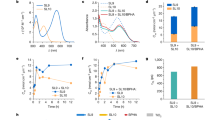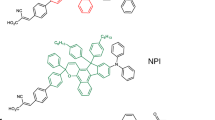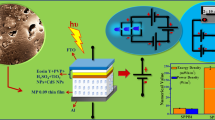Abstract
THE large-scale use of photovoltaic devices for electricity generation is prohibitively expensive at present: generation from existing commercial devices costs about ten times more than conventional methods1. Here we describe a photovoltaic cell, created from low-to medium-purity materials through low-cost processes, which exhibits a commercially realistic energy-conversion efficiency. The device is based on a 10-µm-thick, optically transparent film of titanium dioxide particles a few nanometres in size, coated with a monolayer of a charge-transfer dye to sensitize the film for light harvesting. Because of the high surface area of the semiconductor film and the ideal spectral characteristics of the dye, the device harvests a high proportion of the incident solar energy flux (46%) and shows exceptionally high efficiencies for the conversion of incident photons to electrical current (more than 80%). The overall light-to-electric energy conversion yield is 7.1-7.9% in simulated solar light and 12% in diffuse daylight. The large current densities (greater than 12 mA cm-2) and exceptional stability (sustaining at least five million turnovers without decomposition), as well as the low cost, make practical applications feasible.
This is a preview of subscription content, access via your institution
Access options
Subscribe to this journal
Receive 51 print issues and online access
$199.00 per year
only $3.90 per issue
Buy this article
- Purchase on Springer Link
- Instant access to full article PDF
Prices may be subject to local taxes which are calculated during checkout
Similar content being viewed by others
References
Bucher, K. & Fricke, J. Phys. Zeit 21, 237–244 (1980).
Honda, K. & Fujishima, A. Nature 238, 37–39 (1972).
Tufts, B. J. et al. Nature 326, 681–683 (1987).
Gerischer, H. Electrochim. Acta 35, 1677 (1990).
Licht, S., Hodes, G., Tenne, R. & Manassen, J. Nature 326, 863–864 (1987).
Heller, A. Acc. chem. Res. 14, 154–162 (1981).
Nozik, A. J. Phil. Trans. R. Soc. Lond. A295, 453–470 (1980).
Tributsch, H. & Bennet, J. C. J. electroanal. Chem. 81, 97 (1977).
Wrighton, M. S. Acc. chem. Res. 12, 303–310 (1979).
Bard, A. J. Science 207, 139 (1980).
Memming, R. Phil. Tech. Rev. 38, 160 (1979).
Matsumura, M., Nomura, Y. & Tsubomura, H. Bull. chem. Soc. Japan 50, 2533 (1977).
Alonso, N., Beley, V. M., Chariter, P. & Ern, V. Rev. Phys. Appl. 16, 5 (1981).
Willig, F., Eichberger, R., Sundaresan, N. S. & Parkinson, B. A. J. Am. chem. Soc. 112, 2702–2707 (1990).
Amadelli, R., Argazzi, R., Bignozzi, C. A. & Scandola, F. J. Am. chem. Soc. 112, 7099–7103 (1990).
Nazeeruddin, M. K., Liska, P., Moser, J., Vlachopoulos, N. & Grätzel, M. Helv. chim. Acta 73, 1788–1803 (1990).
Juris, A., Balzani, V., Barigletti, F., Campagna, S., Belzer, B. Coord. Chem. Rev. 84, 85 (1988).
Anderson, M. A., Gieselmann, M. J. & Xu, Q. J. Membrane Sci. 392, 43 (1988).
O'Regan, B., Moser, J., Anderson, M. & Grätzel, M. J. phys. Chem. 94, 8720–8726 (1990).
Author information
Authors and Affiliations
Rights and permissions
About this article
Cite this article
O'Regan, B., Grätzel, M. A low-cost, high-efficiency solar cell based on dye-sensitized colloidal TiO2 films. Nature 353, 737–740 (1991). https://doi.org/10.1038/353737a0
Received:
Accepted:
Issue Date:
DOI: https://doi.org/10.1038/353737a0
This article is cited by
-
Potential and challenges of computing with molecular materials
Nature Materials (2024)
-
Improvement of the photoelectric dye sensitized solar cell performance using Fe/S–TiO2 nanoparticles as photoanode electrode
Scientific Reports (2024)
-
Recent progress toward high-performance dye-sensitized solar cells: a review
Journal of the Iranian Chemical Society (2024)
-
Chemical bath deposition of mercury bismuth sulfide (HgBi2S3) sensitized titanium dioxide (TiO2) thin films: An In-depth analysis and characterization study
Applied Physics A (2024)
-
Mechanistic Study of CrS2/BP as a Direct Z-Scheme Heterojunction for Photocatalyst of Splitting Water Under Biaxial Strain
Catalysis Letters (2024)
Comments
By submitting a comment you agree to abide by our Terms and Community Guidelines. If you find something abusive or that does not comply with our terms or guidelines please flag it as inappropriate.



